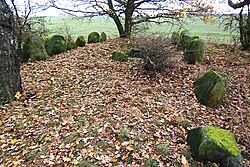Great stone graves from Frauenmark
| Great stone graves from Frauenmark | ||
|---|---|---|
|
The large stone grave Frauenmark 1 |
||
|
|
||
| Coordinates | Frauenmark 1 , Frauenmark 2 | |
| place | Friedrichsruhe , Mecklenburg-Western Pomerania , Germany | |
| Emergence | 3500-2800 BC Chr. | |
| Sprockhoff no. | 409-410 | |
The large stone graves of Frauenmark (also called Frauenmark 1 and 2) are located east of the village, north of the "Dorfstraße" from Frauenmark to Kossebade, in the field No. 1 and south of the road in the forest No. 2. The facilities are located in Friedrichsruhe district of Frauenmark in the Ludwigslust-Parchim district in Mecklenburg-Western Pomerania .
The megalithic systems , an ancient dolmen and a passage grave are large stone graves of the funnel cup culture (TBK) and were created between 3500 and 2800 BC. They have the Sprockhoff numbers. 409 and 410. “Neolithic monuments are an expression of the culture and ideology of Neolithic societies. Their origin and function are considered to be the hallmarks of social development ”. The facilities were excavated and reconstructed by Adolf Hollnagel in 1965 .
The Urdolmen
It is a well-preserved, approximately 14.5 m long north-west-south-east oriented trapezoidal barn bed with a small, transverse chamber (transverse lying) made of three supporting stones and a capstone. Two angled guard stones (one with a bowl ) stand at the northwest end of the here 8.5 m wide barren bed. The two stones on the narrow side are missing at the approximately 6.3 m wide southeast end. The remaining 21 curbs have been preserved. From the 1.2 m high, 2.3 m long and 1.6 m wide chamber, all supporting stones and a chamber-high half stone on the access side have been preserved. The remainder of the single capstone lies next to the chamber, which is sunk into the ground up to the top edge of the bearing stones. The floorboard consisted of rubble, annealed flint and clay screed . The finds consisted of a flat ax, a cross cutter and a wide-mouthed vessel.
The passage grave
The east-west-oriented complex is a passage grave in the Rollsteinhügel with access in the south. The 1.8 m high, 7.7 m long and 3.0 or 1.8 m wide trapezoidal chamber consists of 12 supporting stones, all of which are present. One of the stones has nine bowls . The western keystone is broken, the eastern one pushed outwards. Two of the four cap stones are in and two next to the chamber. The stone next to the southern long side is probably one of the cap stones of the entrance . Remains of the intermediate masonry made of small stones can still be seen between some of the supporting stones on the long sides . The finds on the floorboard made of clay screed consisted of 26 shards, two heart-shaped arrowheads and a striking stone .
Nearby is the Friedrichsruhe dolmen .
See also
literature
- Adolf Hollnagel : The large stone graves of Frauenmark, Parchim district. In: Ground monument maintenance in Mecklenburg. Yearbook 1966. 1967, pp. 183-200.
- Luise Lorenz: Ceramic lifetimes and the useful life of northeast German megalithic graves. In: Martin Hinz, Johannes Müller (eds.): Settlement, trench works, large stone grave. Studies on the society, economy and environment of the funnel cup groups in northern Central Europe (= early monumentality and social differentiation. Volume 2). Rudolf Habelt Verlag, Bonn 2012, ISBN 978-3774938137 , pp. 61-86 ( online ).
- Ewald Schuldt : The Mecklenburg megalithic graves. Investigations into their architecture and function (= contributions to the prehistory and early history of the districts of Rostock, Schwerin and Neubrandenburg. Vol. 6, ISSN 0138-4279 ). German Science Publishing House, Berlin 1972.
- Ernst Sprockhoff : Atlas of the megalithic tombs of Germany. Part 2: Mecklenburg - Brandenburg - Pomerania. Rudolf Habelt Verlag, Bonn 1967, pp. 36–37.
Individual evidence
- ↑ J. Müller In: Varia neolithica VI 2009 p. 15
- ↑ This in Mecklenburg-Vorpommern frequently encountered stone cover (no cairn or Röse ) is a thin layer of stone pebbles on a mound, which prevent erosion or the optics should impart a stone hill



